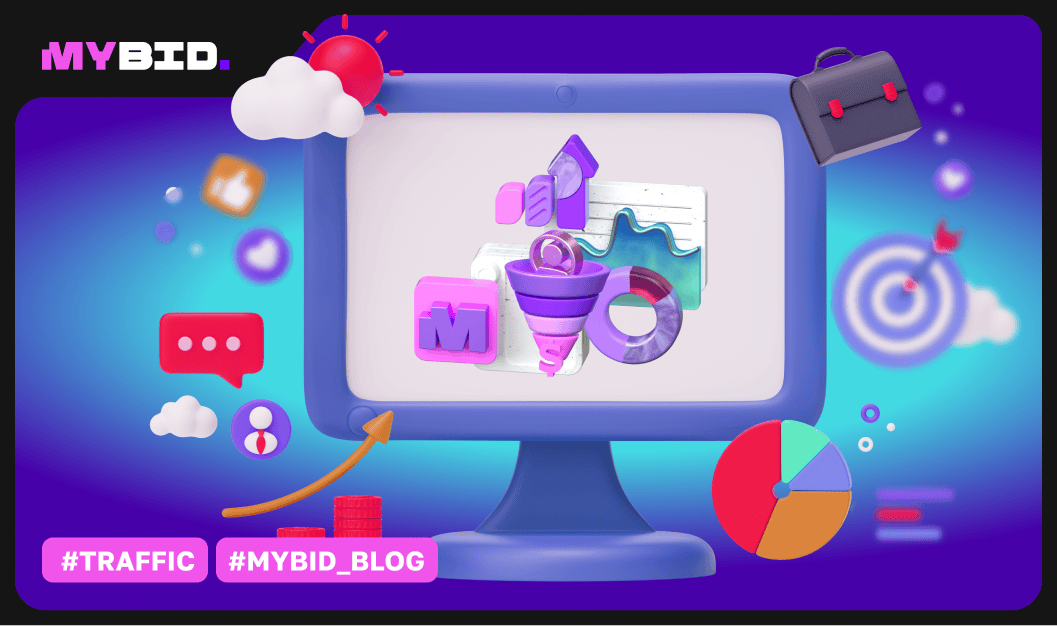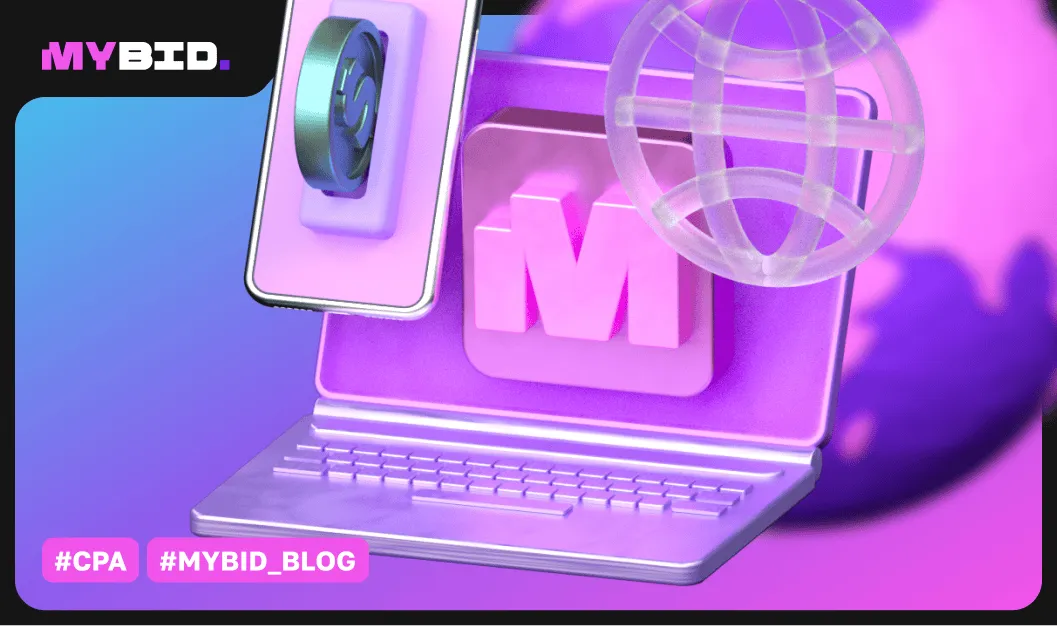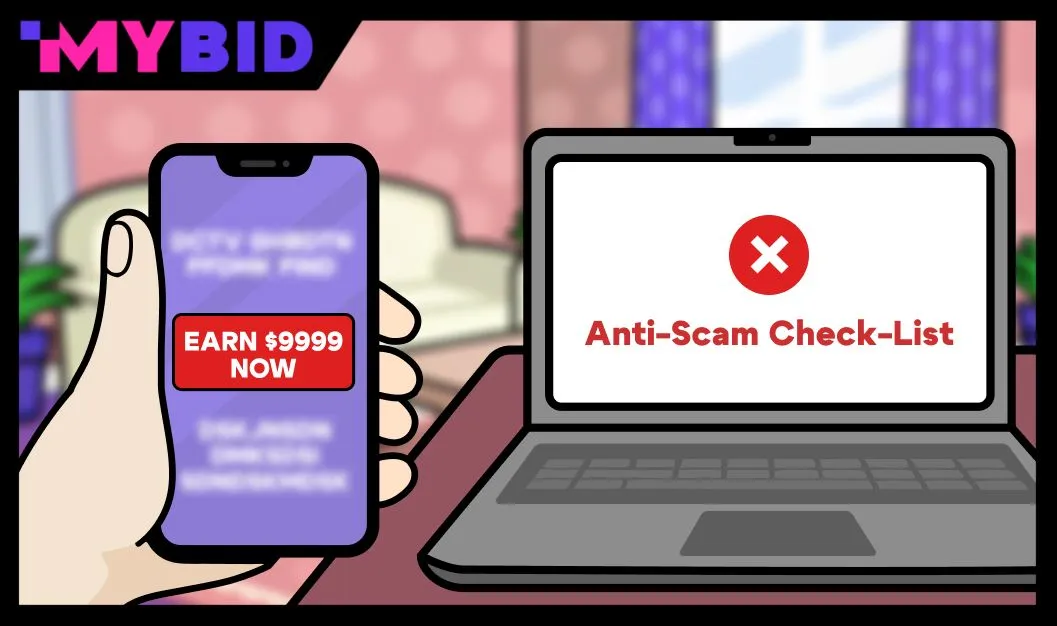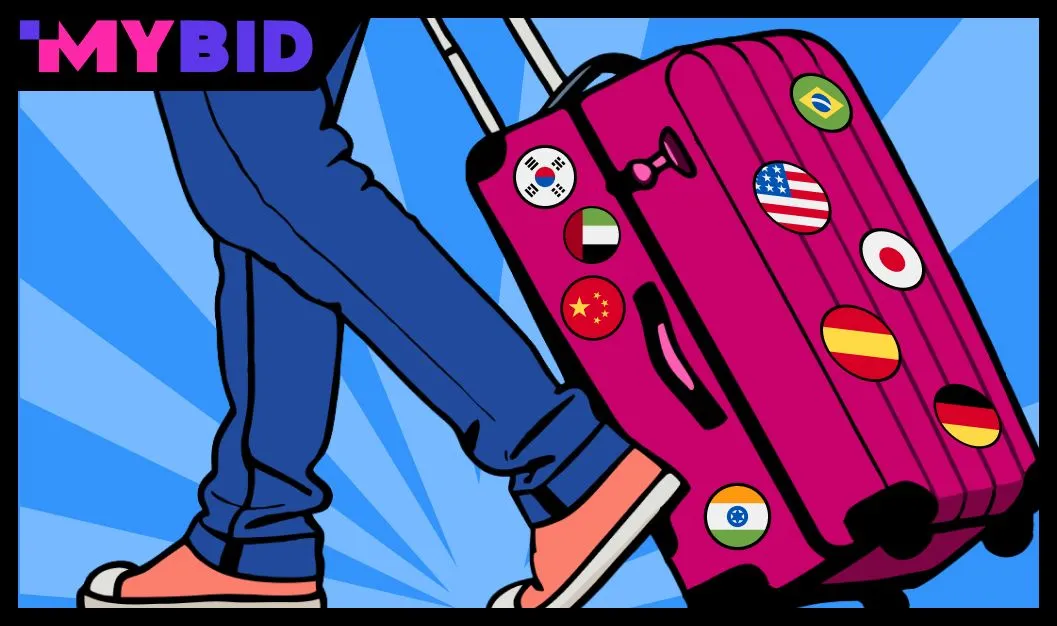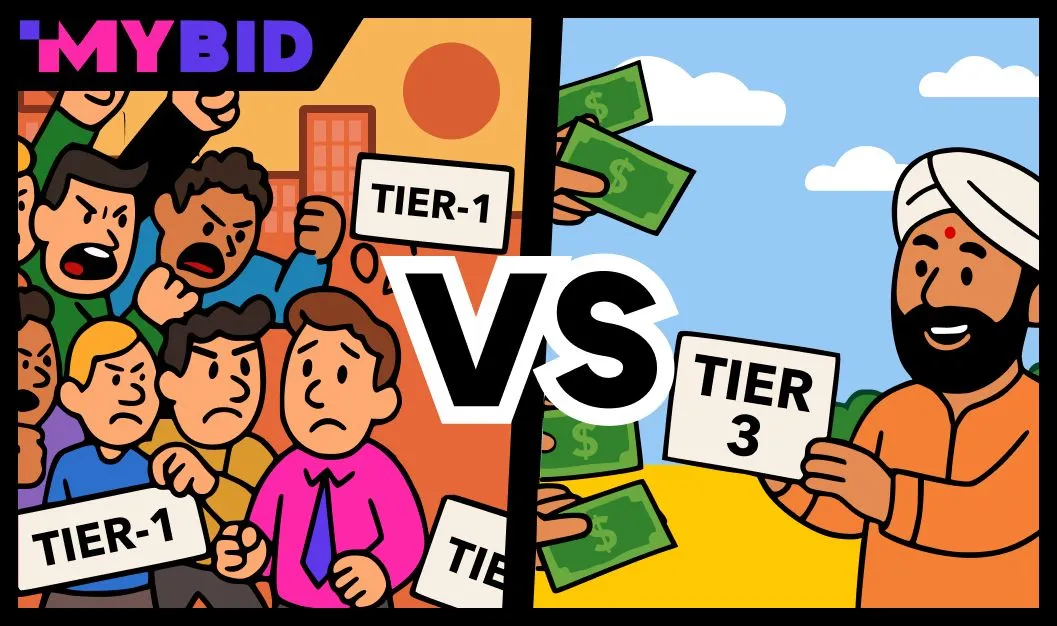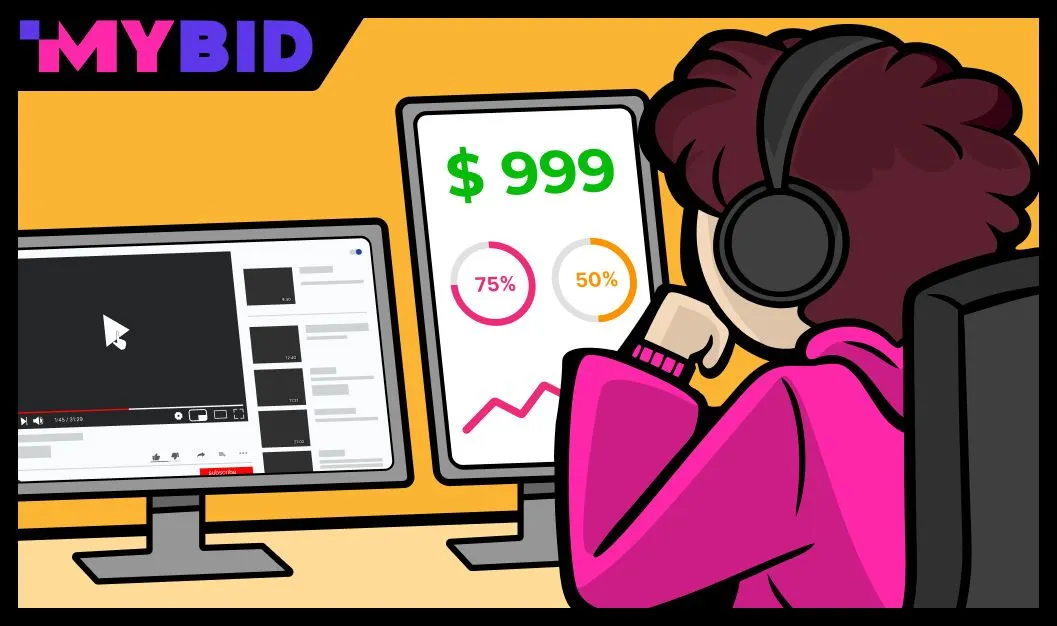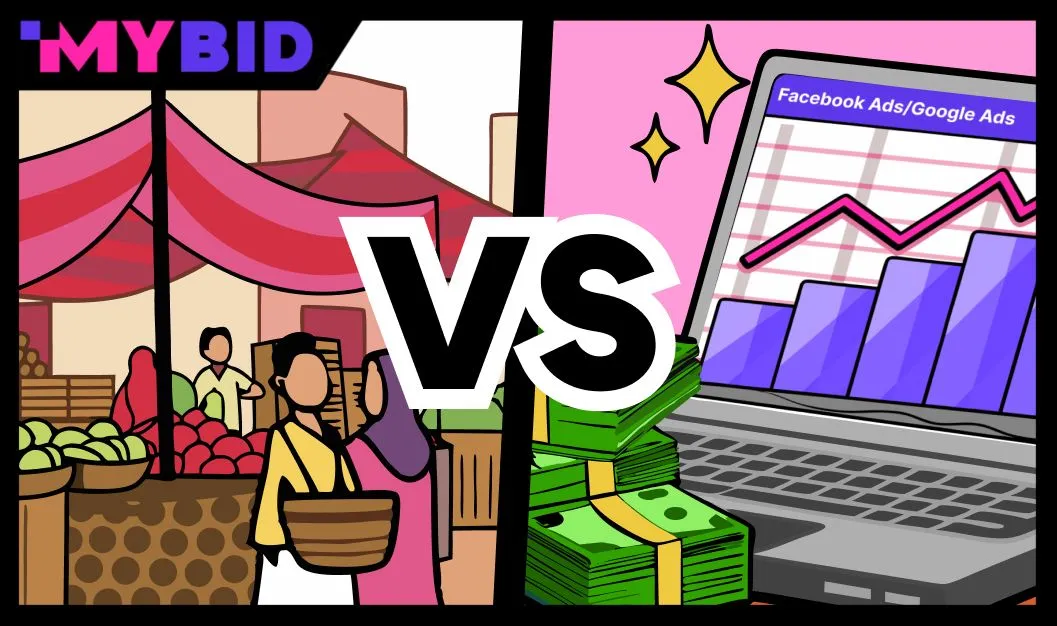Most websites are created with the goal of either monetizing the content they publish or promoting a business, including its goods, services, or brand. When someone creates a website to make money, they face several important questions. Here are some of the main ones:
- Where can they get traffic from?
- How can they attract traffic for free?
- Where can they buy traffic?
- What sources are available to attract visitors?
Experts from the MyBid advertising network, a company specializing in working with traffic from over 200 different geos, have decided to share their extensive experience to help publishers learn how to increase their website traffic.
In this article, we will discuss both free and paid methods for attracting traffic to your website. We will provide guidance on where and how to purchase targeted traffic, as well as share useful tips to help you monetize your site more effectively.
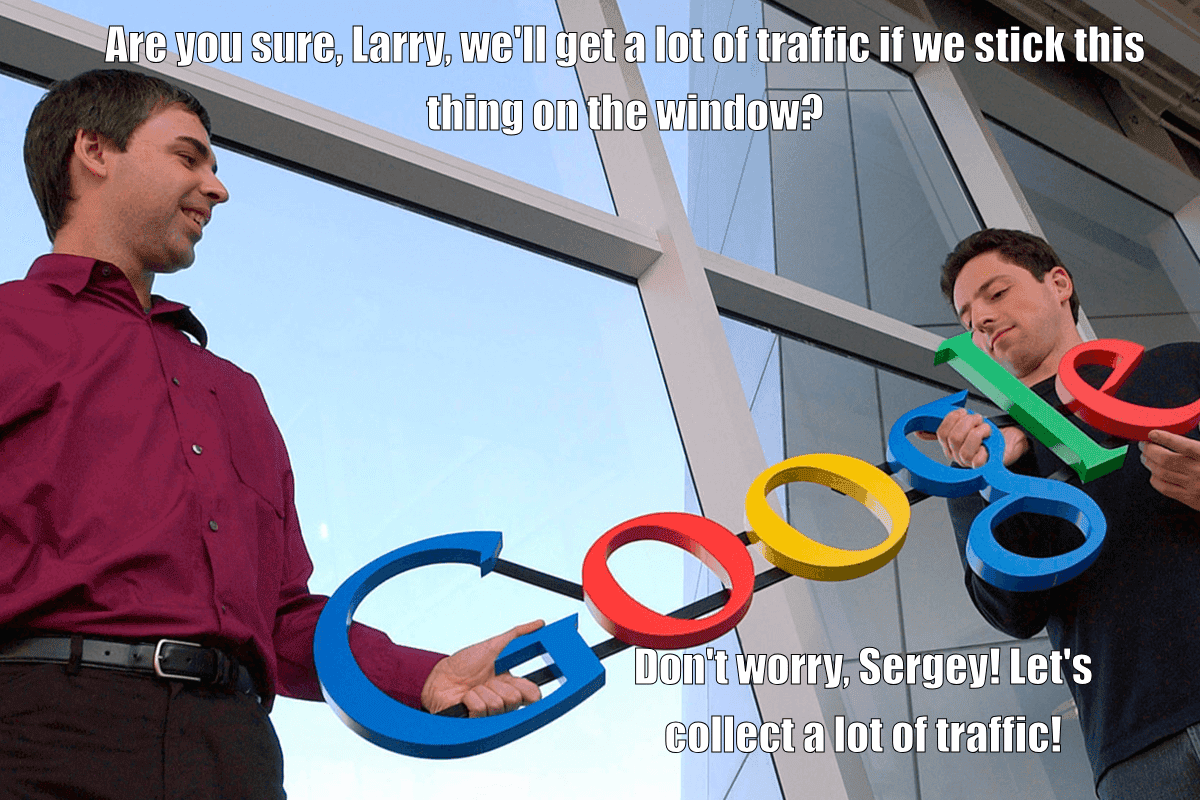
What is traffic?
Let's first understand what we mean by "traffic." In this context, traffic refers to the number of visitors a website receives within a specific period of time. High website traffic indicates that the site's content is interesting to users. This allows the website owner to earn money through advertising integrations or by promoting their own products or services.
An important aspect of traffic is the quality of visitors. To successfully monetize a website, it is crucial to attract a target audience that is genuinely interested in the published materials. Now, let's dive into the various methods of obtaining traffic.
Where to get visitors
There are different ways to attract people to your website. Some methods are free and allow you to gather organic users, such as those who find your website through Google search results. On the other hand, there are paid methods that involve paying an intermediary for each unique visitor to your website. These paid methods aim to accumulate an audience on your behalf. In this article, we will focus on understanding how to increase traffic using paid methods.
Where to purchase paid traffic
When it comes to purchasing traffic, there are many options available. Apart from well-known paid traffic sources, there are also ad networks that cater to different types of websites. In the following sections, we will describe some of the most relevant traffic sources for paid advertising in 2023.
Google Contextual Targeting
Google contextual targeting is a highly effective method for driving website visits, as the majority of internet users rely on the Google search engine. Contextual ads are displayed in search results based on relevant keywords, making them more likely to capture the attention of interested users.
The success of contextual advertising depends on the quality of the campaign setup. By selecting the right targeting options, ads are shown exclusively to an audience interested in the product or service. This means that users will see advertisements in their search results that align with their query, increasing the likelihood of them clicking on the ad. For example, when searching for "how to choose a robot vacuum cleaner," Google displays a block of ads from various sellers, complete with prices and product ratings.
This visual presentation often proves more appealing to users than links to review sites. It can be concluded that contextual advertising occupies prime positions in the search results, effectively attracting users.

Furthermore, contextual advertising can be used even for non-commercial queries to drive visits to a website. For instance, when searching for "how to learn Italian quickly," the top results on Google include advertisements for language courses.

The advantages of contextual advertising include:
- Precise targeting: Advertisers can set specific targeting parameters to attract the right audience, ensuring that their ads reach interested users.
- Non-intrusiveness: Unlike push notifications, contextual advertising is only seen by users who enter relevant queries in their search, making it less intrusive.
- Paying for desired results: Advertisers have the flexibility to pay for specific outcomes, such as impressions, clicks, or mobile application installations.
- Quick results: Contextual advertising begins to work almost immediately after the ad is reviewed and approved.
The main drawback of Google Ads is its cost. In highly competitive industries, the cost per click on an advertisement can be quite high, reaching up to $100. As a result, only companies with substantial advertising budgets can afford to promote goods or services in lower price ranges.
Remarketing
Remarketing is a marketing strategy that serves as a logical extension of contextual advertising. Its core concept involves displaying targeted ads to users who have previously visited a website or shown interest in a particular product or service. With remarketing, advertisers aim to reconnect with these users and encourage them to complete a desired action.
The process of remarketing works by placing a tracking pixel or code on the advertiser's website, which enables the collection of data about user behavior. Afterward, when these users browse the internet, they may encounter relevant ads related to their previous interactions with the website. This can be seen as a way to remind and persuade users to take the desired action they didn't complete during their initial visit.

Remarketing offers several benefits, including the ability to target visitors who have already shown interest in a brand or product. These visitors are considered "warmed up" as they have prior familiarity with the website or offer, which can lead to higher conversion rates compared to first-time visitors. It has been observed that remarketing campaigns tend to have 40-50% higher conversion rates.
However, there are some drawbacks associated with remarketing. One of the challenges is the cost and complexity involved in setting up an effective remarketing campaign. It requires proper configuration of targeting options, ad placements, and frequency capping to ensure optimal results. Additionally, remarketing may require a higher investment compared to other advertising methods.
Social media targeting
Compared to search engines, where people have specific queries, social networks provide a platform for users to have fun, communicate, and engage in various activities. Therefore, companies that have an active presence on platforms like Twitter, Facebook, Instagram, and others have a better chance of gaining the trust of their target audience. Additionally, social networks offer the opportunity to create targeted advertisements, which can effectively drive traffic to a company's website.

From a traffic acquisition perspective, advertising on social networks offers the following advantages:
- Wide targeting options: Advertisers can select specific regions where their ads will be displayed, as well as target audiences based on socio-demographic characteristics, gender, age, user devices, and other parameters.
- Testing advertising campaigns: Social networks allow businesses to conduct experiments with different target audience groups, creatives, and landing pages. This enables them to test various hypotheses and optimize their campaigns for better results.
- Cost-effective traffic generation: Social networks provide the opportunity to drive traffic to a website even with a minimal budget. This makes it accessible for businesses of different sizes to leverage social media advertising for their marketing goals.
In addition to the listed advantages, social networks offer the advantage of capturing and maintaining user attention on the promoted product or brand. This is particularly valuable for businesses that prioritize customer lifetime value (LTV) as it helps in building brand awareness, fostering engagement, and nurturing long-term customer relationships.

Influencer traffic
Among all the ways to attract paid visits, advertising with influencers has become widespread this year. Not only large whitehat brands but also high-risk grayhat products are successfully promoted through these opinion leaders. Increasingly, on YouTube and Telegram, you can see celebrities promoting gambling, betting, and crypto offers on their online broadcasts.
The essence of this method is a collaboration with an influencer who will post a link to the resource on their public page for a fee. They will also advertise the site in their posts, stories, videos, and through other means of engaging with their audience.
The advantage of influencer marketing is that each advertising integration greatly boosts traffic to the promoted site, increasing the volume of visits tenfold. However, there are some disadvantages to this method, which include:
- The difficulty of finding an influencer with a relevant audience: Not every product can find an opinion leader whose audience aligns with the target market. Additionally, influencers may not be willing to promote all topics to their followers.
- Balancing the cost: There is a need to find a balance between the high cost of advertising with celebrities who have a multimillion-dollar audience and lesser-known influencers who offer more reasonable prices.
It's worth emphasizing that a large influencer audience is not always a guarantee of success. The relevance of the promoted resource's subject matter is crucial. For example, promoting an online casino through a beauty influencer with five million followers would not make much sense. Even if the influencer advertises the site, it would not have a significant impact on its traffic since there are unlikely to be many gamblers among their followers. In such cases, the collaboration costs may not pay off.
To illustrate the use of influencers in promoting gambling, here's the case of Luxury Girl. This individual gained popularity through her videos on platforms like PornHub and built a large following on social networks. Later, she decided to shift her focus to streaming games in online casinos. Luxury Girl created her own showcase website with several products and drives users there from her broadcasts. Given that the interests of her audience extend to both adult content and gambling, she effortlessly manages to attract 30-50 first-time deposits (FTDs) per broadcast. She turns each broadcast into a thematic show that captivates her audience.

Push traffic
Push notifications are a valuable tool for publishers as they offer benefits in both monetization and promoting their own websites. Publishers can integrate with advertising networks to monetize their resources through push advertising. Simultaneously, they can utilize push notifications to promote their own websites on other platforms, expanding their audience and increasing their income from push advertising.
In the past, push ads were considered annoying to users, prompting search engines to discourage their use. As a result, classic push notifications can now only be displayed if users grant permission, which has reduced their effectiveness.
However, technological advancements have led to the development of the In-Page Push format, which does not require user permission to display notifications. This format remains one of the most cost-effective ways to generate traffic for websites. In MyBid, the cost per click in this advertising format can start as low as $0.00003.
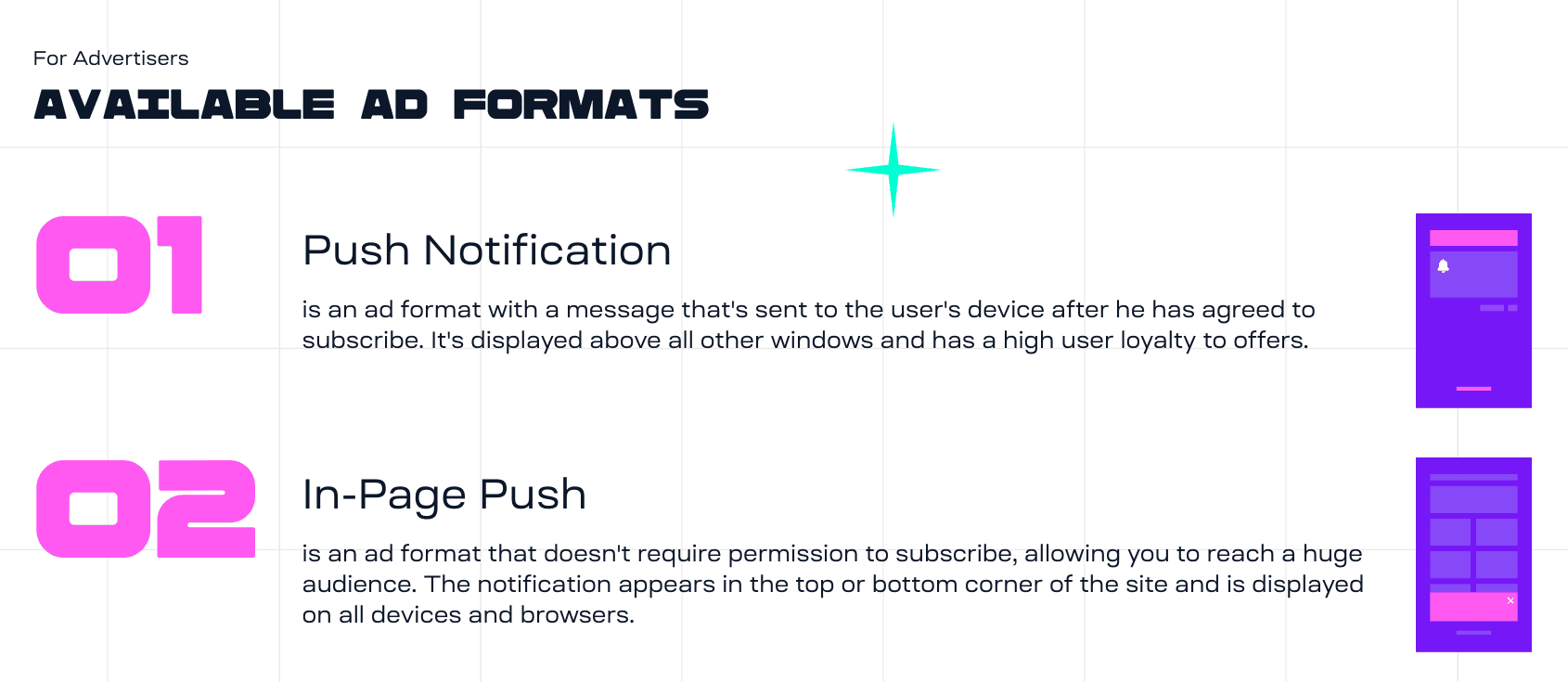

The advantages of push notifications include:
- Versatility: Push notifications can be used to promote offers in various niches, including dating, gambling, nutra, and other categories that may be considered "grayhat niches."
- Cost-effectiveness: Push notifications offer low traffic costs, making them an attractive option for publishers.
- Targeting options: There is a wide range of targeting settings available for push notifications, allowing publishers to reach their desired audience effectively.
- Managed system: Some advertising networks, such as MyBid, provide a fully managed system where the campaign setup, optimization, and scaling are handled by a manager. This relieves publishers from the need to understand all the details of campaign settings and allows them to focus on their core business.
However, push notifications also have some disadvantages. One major concern is the prevalence of bots on many websites. It is advisable to choose an advertising network that employs an in-house anti-fraud solution to mitigate this issue. Implementing such measures can significantly reduce bot traffic, and in the case of the mentioned company, it has resulted in a reduction to just 5%. Additionally, the fact that 90% of all sites belong to the advertising network further contributes to minimizing bots. These factors enable advertisers to purchase genuine visitors for their websites.
Where to get free traffic
Organic traffic holds tremendous value because users who engage with websites without any external motivation tend to have the highest conversion rate for the desired action. Now, let's explore some effective ways to boost your website's traffic without spending a dime.
Services for attracting traffic from Google
One of the most effective ways to attract traffic without spending money is by leveraging Google's search engine services. They're easy to set up, widely known among users, and actively used by the audience.
Google My Business
To add your company to this service, simply fill out the required fields and wait for a confirmation code that will be sent to the email address you provided during registration. Sometimes, Google can even verify your address over the phone.
Once your company is listed on Google My Business, a prominent information block about your business will appear on the right side of search results. Users can quickly get essential details about your company, take the desired action, read reviews, or find your company's address on Google Maps, all without visiting your website.

The great thing about this service is that the information block stands out significantly compared to other resources for relevant search queries. You can also use Google My Business in contextual advertising by including your address in the advertisement. This will add one or two extra lines to your search result link, pushing your competitors further down the page.

Google Blogger
Creating a blog on this platform can be a fantastic way to engage with your potential audience and gradually guide them to your main site. When you create a blog, you'll get a free third-level domain and access to Google's large user base, allowing you to attract more users. Blogs with high-quality content tend to rank well in search engine results.

In addition, you can monetize your blog by displaying advertisements within your articles. Depending on the length of the article, you can include up to four advertising blocks. However, keep in mind that monetization is only available for blogs with more than eight published articles.
To optimize your blog articles for search engines, it's important to include informative keywords related to your desired topic. But be careful not to overdo it—Google doesn't like content that's written solely for promotion and lacks value for readers.
A blog is an excellent option for driving traffic to marketplaces, aggregators, information portals, and websites that sell business-related goods. However, if you're selling inexpensive products that are often purchased on impulse, a blog might not be as effective.
When promoting your main site through a blog, it's crucial to strike a balance between providing valuable information and including relevant links. If you include too many links to your main site, users might think your article is too promotional and not read it. On the other hand, if you have too few links, users might read your useful blog content but leave without reaching your main site, potentially going to another seller.
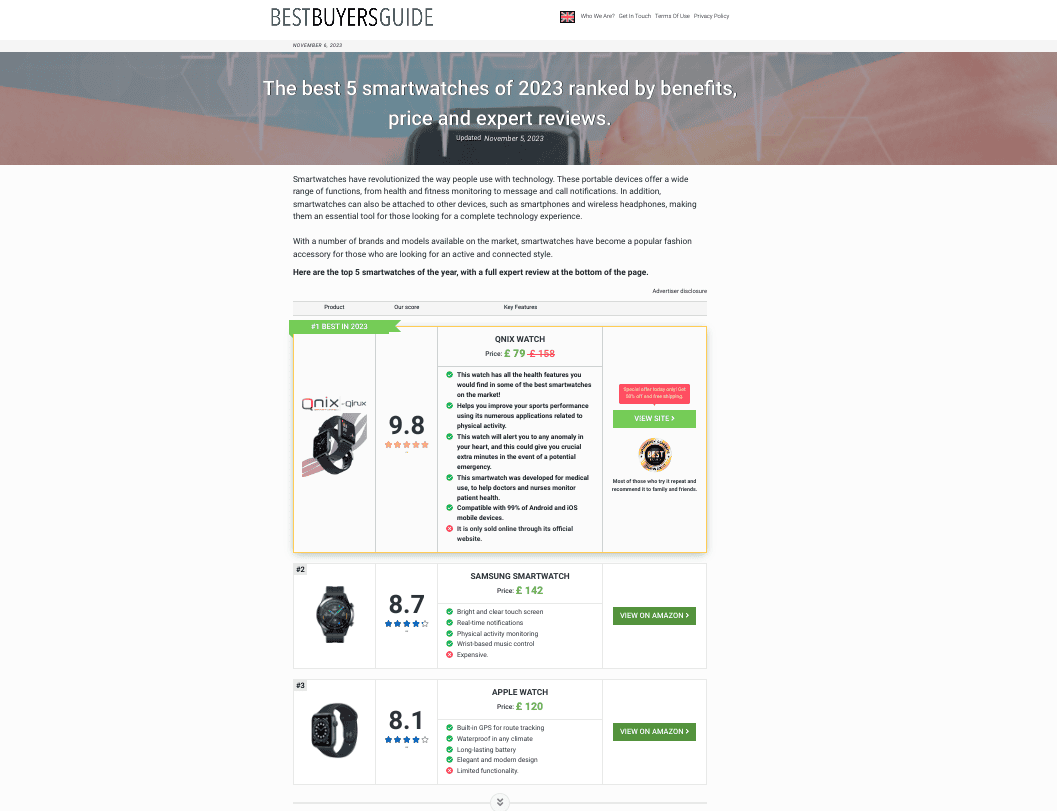
Keep in mind that a blog is an organic way to attract users, which means you don't have to pay for advertising. However, you will need to invest in creating quality content for your blog.
More options for getting traffic to your site
In addition to using Google services, you can also attract people using the following methods.
Engaging with competitors' posts and featured articles
One way to attract attention is by leaving insightful comments under blog articles or posts related to your niche. For example, if you come across an article about "how to meet a girl on the Internet," you can leave a comment expressing appreciation for the content and share your own interesting experience. You can then mention that you've discussed it on your own platform, and include a link to your thematic platform. By doing so, you can drive traffic to your site, which monetizes by publishing dating offers from affiliate programs.

Expanding your reach through interviews
To increase your reach, consider inviting leaders from companies in your industry to participate in interviews or podcasts. This approach allows you to showcase their insights and achievements, fostering collaboration and mutual benefit.
The video interview can then be shared on both your and the competitor's websites. By leveraging mutual advertising, you can attract their audience to your channel and subsequently redirect them to your CPA network website. This mutually beneficial advertising approach enables you to attract traffic without incurring any direct costs.
Leveraging niche site partnerships for cross-promotional campaigns
Online aggregators often host thematic platforms that cater to specific interests, such as "top tens" of VPN services, video processing software, dental clinics, law firms, and more. While securing placement on renowned resources can be expensive, there are free alternatives available.
Identify websites with a similar target audience as yours and propose a joint publication for mutual PR. For instance, if you own a blog about renting motorhomes in Spain, you can collaborate with a publisher who provides information on campsites, the best places to stay, and local attractions.
The publisher of another website could include information like this on their main page:
"Here, you can find campsites and the best places to stay in the Barcelona area.
Our articles will help you navigate the streets of Madrid and guide you through the city's attractions without traffic jams.
Here you will get answers to questions about where to have a delicious dinner in Seville.
This article offers information on bicycle rentals for traveling to Santiago de Compostella and motorhome parking.
Discover a motorhome traveler's guide to Valencia here."
By including a paragraph about your platform in their article and reciprocating the favor, you can generate high-quality traffic from these thematic resources without competing directly.

Organizing competitions, promotions, and sweepstakes
People are drawn to giveaways and prizes. Therefore, hosting various events where participants can win or receive free items is an effective way to increase website traffic. Social networks are particularly suitable for such activities. A well-promoted profile with a substantial number of likes, comments, and engagement will inspire trust in the audience, encouraging them to take part in ongoing events.

The actions required for participation are typically simple, yet they allow you to collect valuable data such as email addresses, social media usernames, and phone numbers. In addition to generating website visits, the contact information obtained enables you to engage in remarketing efforts.
Similar to blogging, conducting promotions and sweepstakes can be considered a cost-effective method of attracting users. However, the website owner will need to offer the product or service for free or at a discounted rate in exchange.
Conclusion
Before we wrap up, it's important to keep in mind that there is no one-size-fits-all approach to generating a large amount of traffic. It's a good idea to experiment with different methods, combine them, and see which ones work best for your specific platform.
However, it's equally important to understand that attracting traffic is just the beginning. To keep users engaged and encourage them to return, there are several key actions you should take:
- Regularly create unique and valuable content that appeals to your target audience.
- Enhance your content with visual elements such as photos and videos to make it more engaging and appealing.
- Optimize image tags to improve accessibility and visibility on search engines.
- Provide high-quality photos and detailed product descriptions to effectively showcase what you have to offer.
- Stay updated with relevant keywords and semantic content to ensure your visibility in search engine results.
- Monitor your page loading speed and optimize it for a smooth and seamless user experience.
- Make sure your platform is mobile-friendly and works well on different devices.
- Use a combination of medium and low-frequency keywords to effectively promote your platform.
- Implement proper internal linking to improve navigation and enhance the overall user experience.
- Create a simple and user-friendly navigation structure that makes it easy for visitors to find what they're looking for.
All the information provided above about attracting and retaining traffic ultimately aims to help you monetize your platform effectively. While it may be tempting to fill your site with advertisements and push notifications, it's crucial to prioritize the user's interest and experience. When it comes to monetization, seeking professional guidance can be valuable in developing a profitable strategy to generate revenue from your website.
The MyBid advertising network has a wealth of experience working with over a thousand successful websites that have effectively monetized their traffic. Their team is excited and eager to help you develop a profitable strategy to generate revenue from your site. You can rely on their expertise and support to make the most out of your website and achieve your financial goals.
